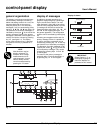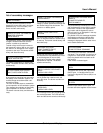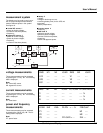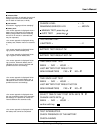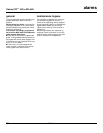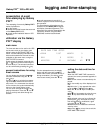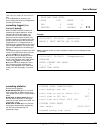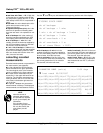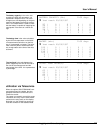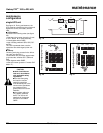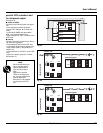
23
environment information
Terminals XR2, XR3, XR4 and XR5 on the
"Media Contacts 11" board of each type of
unit can be used to receive signals from
the operating environment and to transmit
signals concerning the operating status of
the UPS (see figure 16 for the position of
the board, item 12).
signal reception
The signals should be provided by volt-
free contacts.
■ emergency off:
An NC contact causes shutdown of the
inverter and the rectifier/charger, opening
of the battery circuit breaker, blocking of
the static bypass and activation of a relay
contact on the "Media Contacts 11" board;
■ battery room ventilation fault:
An NO contact causes shutdown of the
rectifier/charger;
■ battery circuit breaker QF1 closed:
An NO contact prevents inverter start-up if
the circuit breaker is open;
■ battery temperature:
A PC-board, placed near the battery, sup-
plies information on the battery tempera-
ture, thus enabling the rectifier/charger to
regulate the battery voltage;
■ "auxiliary" signals:
Depending on the selected settings, these
signals may be used to provoke:
❏ forced shutdown of the inverter (whatev-
er the status of the bypass AC source),
❏ protected shutdown of the inverter (load
transfer to the bypass AC source).
❏ limiting of the current drawn by the recti-
fier/charger (programmable value) when
supplied by an engine generator set with
an insufficient power rating. The additional
power required by the inverter is supplied
by the battery which discharges,
❏ limiting of the battery charge current
(programmable value) if the normal AC
source is replaced by an engine generator
set with an insufficient power rating.
signal transmission
■ an auxiliary 24 V power supply, isolat-
ed and backed up, is used to supply:
❏ the undervoltage release of the battery
circuit breaker(s) QF1,
❏ the board that measures the tempera-
ture in the battery room;
■ "low battery" warning signal (volt-free
changeover contact) indicating that battery
time is about to run out. The warning
threshold may be personalized;
■ "load on UPS" signal (volt-free
changeover contact) indicating that the
load is supplied by the inverter. For a sin-
gle-UPS unit, one volt-free changeover
contact may be used to indicate that the
load is supplied by the bypass AC source;
■ "load on battery power" signal (volt-
free changeover contact) indicating that
the inverter is supplied by the battery in
the following cases:
❏ normal AC source outage or voltage
drop,
❏ rectifier/charger shutdown,
❏ rectifier/charger current limiting.
This signal, which may be used to initiate
process saving and shutdown procedures,
is time-delayed 30 seconds to avoid
unnecessary operations following micro-
breaks;
■ "maintenance position" signal (volt-
free changeover contact) indicating that:
❏ maintenance bypass switch Q3BP is
closed,
❏ bypass AC source input switch Q4S is
open,
❏ inverter output switch Q5N is open,
❏ battery circuit breaker QF1 is open;
■ signal to open battery circuit break-
er(s) QF1 in the event the "emergency off"
button is pressed or to avoid an excessive
battery discharge (lasting more than three
times the rated backup time plus two
hours);
■ repo contact (volt-free changeover con-
tact) used to trip switching devices in the
event of an emergency shutdown.
■ "general alarm" information (volt-free
changeover contact) which includes:
❏ internal faults,
❏ information on temperatures outside tol-
erances in the battery room (optional),
❏ overload information (> In),
❏ static-switch ventilation and power-sup-
ply faults.
NOTE
The maximum breaking
capacity of the
changeover contacts is
5A at 250V.
Environment Information
User’s Manual



